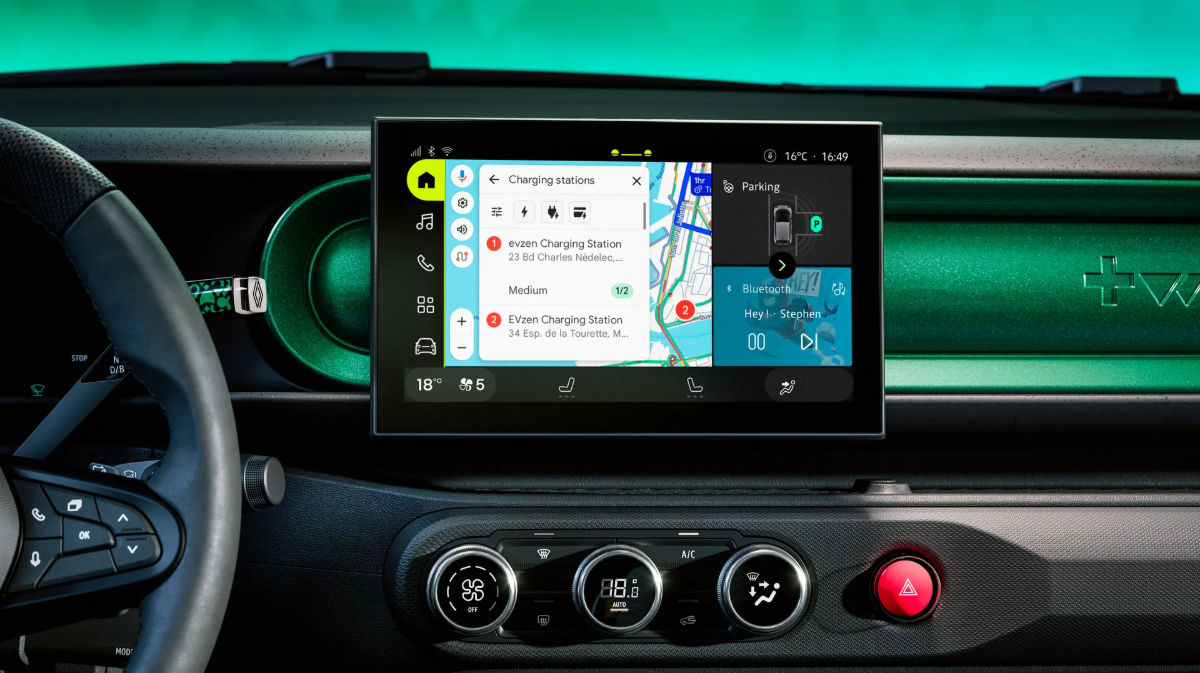Support CleanTechnica’s work through a Substack subscription or on Stripe.
Renault is pretty chuffed about its next generation Twingo, a battery-electric city car that will sell for less than €20,000. Here’s the headline from their press release about the car: “New Twingo — sparking joy in cities and brimming with tech.”
We don’t often hear car companies talk about bringing joy to their customers, but we like their enthusiasm. Personally, when I saw the photo that heads that press release, it reminded me of the multi-colored candy slices my old Irish …
Support CleanTechnica’s work through a Substack subscription or on Stripe.
Renault is pretty chuffed about its next generation Twingo, a battery-electric city car that will sell for less than €20,000. Here’s the headline from their press release about the car: “New Twingo — sparking joy in cities and brimming with tech.”
We don’t often hear car companies talk about bringing joy to their customers, but we like their enthusiasm. Personally, when I saw the photo that heads that press release, it reminded me of the multi-colored candy slices my old Irish grandmother used to keep on the top shelf of a closet in the kitchen she thought I couldn’t reach and the memory made me smile.
 Credit: New York Spice Shop/Amazon
Credit: New York Spice Shop/Amazon
The Renault presser says, “The chirpiest city car on the market has kept all of its playful features and invigorating vibe. And it has remained true to its original spirit with its nice price, everyday practicality, and gutsy attitude. And there’s more: the city car that shook up its market now comes with the best electric driving experience in its segment and equipment from the segments above.”
When the first Renault Twingo was released in 1992, “it rewrote the rule book with its curvy shape, blissful look, driver-friendliness and everyday practicality. Now Twingo E-Tech electric has reinvented the original Twingo spirit with an up-to-the-minute edge — and affordable price,” the company says.
“Renault Twingo E-Tech electric will retail at less than €20,000, before incentives. At this competitive price point for an all-electric model, Renault is also packing this car with features and equipment you expect higher up the line — plus it puts a smile on your face!” said Renaut spokesperson Grégoire Ginet.
 Credit: Renault
Credit: Renault
The enthusiastic press release focuses on the the colorful cabin with its 7-inch instrument display and 10-inch centrally mounted infotainment screen. “Renault Twingo design is playful, but its onboard technology is serious!” the company says.
An integrated Google link, which is standard on the techno version, is simple and intuitive to use with either touchscreen or by using built-in voice commands. This feature is usually only available in higher-end cars and gives the New Twingo an advantage in terms of everyday convenience for the driver as well as passengers.
“Twingo E-Tech electric is Renault’s way of mainstreaming electric vehicles and bringing the switch within reach for the many. To achieve this, Renault Twingo is the first city car on the market to feature a connected multimedia system with Google built-in. Google is one of the best tools to make life easier for people in our electric vehicles,” said Marion Joly, the Twingo E-Tech project manager.
Having Google built in allows drivers to access it best in class navigation system, which suggests the best route and optimizes it continuously to take into account charging stops, station availability and characteristics, and the charging service provider.
ADAS Is Baked In
The Renault Twingo E-Tech electric is packed with high tech safety and comfort amenities, including hands-free parking — a first for cars in its market segment — and 12 front, side, and rear sensors to assist the driver. The ADAS suite includes automatic rear emergency braking and occupant safe exit alert.
“The generous array of driver assistance systems notably includes traffic sign recognition, lane keeping, front sensors with emergency lane keeping, blind spot warning and adaptive cruise control. Behind its joyful demeanor, this city car is packed with technology,” said Marc-Antoine Sanchez, the head engineer for the Renault Twingo.
The company claims proudly that the Renault Twingo stands out among its A segment peers with its spacious interior, one pedal driving (standard on the Techno trim level), LED headlights and daytime running lights, and variety of wheel sizes up to 18 inches. “Its on-road performance is impressive, too, thanks to its low weight. It has the same front axle as Renault 4 and 5 and is based on the company’s AmpR Small platform.
“One Pedal Driving, which you activate from the paddles on the steering wheel, is the most powerful regenerative braking mode. When you release pressure on the accelerator pedal, the vehicle decelerates and comes to the stop, so you don’t have to apply the brakes. It’s useful in traffic jams and at red lights,” said Marion Joly.
Small On The Outside, Big On The Inside
The New Twingo E-Tech is only 2.49 meters long (a touch over 8 feet!), but with its high roof and movable rear seat, passengers in the rear can have as much as 160 mm of knee room. In the alternative, the trunk can hold up to 350 liters of stuff, which is a lot, assuming you are not carrying a steamer trunk or two. But with the rear seat folded, that number shoots up to 1000 liters, so maybe a modest size steamer trunk would fit after all.
Inside EVs added its perspective on the diminutive new Twingo. “Renault wants its new Twingo E-Tech to undercut all the budget models coming in from China. Cars like the BYD Seagull (also known as the Dolphin Surf) are excellent and offer remarkable value for the money, but Europeans would still choose something local if it were similarly priced. At least that’s what Renault hopes, and it’s making extra sure of that by injecting some nostalgia into the mix,” it said.
Specs, Specs, & More Specs
The new Twingo E-Tech would have very little appeal for US drivers, who have suddenly decided they all need 7-passenger (8 is even better) vehicles that get 10 mpg or less. It comes with a 27.5 kWh LFP battery pack. Renault says transitioning to LFP allowed it to reduce the cost of the battery pack by 20%. Range (WLTP) is 262 km (163 miles).
Deduct about 15% to get an EPA equivalent number and you come up with somewhere around 140 miles. The battery is just a skoosh bigger than the one in the original LEAF, which had a maximum range of about 80 miles — but the one I had for two years really never liked to go more than 70 miles on a charge. So over the last 13 years, range per kWh has increased by roughly 60% as manufacturers have learned how to make more efficient electric cars.
The Twingo has an 60 kW (80 hp) motor with 175 Nm (129 lb-ft) of torque, so acceleration is leisurely for an EV but about on par with other A class vehicles. 0 – 100 km/h takes 12.1 seconds. Top speed is 130 km/h (81 mph), which happens to be the speed limit on most highways in Europe. A stat that will make one of our regular CleanTechnica readers smile is that the car weighs just 1200 kg (2,645 lb). That is double the weight of the original Honda Civic, but quite light for an electric car today.
Charging performance is a weak spot for the Twingo E-Tech. To save money, Renault only gave it the ability to charge at 50 kW of DC power. That is equivalent to the original 2017 Chevy Bolt, but the battery is so small that a full charge still only takes about 30 minutes using a fast charger. This is not the car you would use for a fast road trip from Paris to Villefranche-Sur-Mer. You would still take the Facel Vega in your garage for that.
There is an 11 kW AC charger built in, which allows for the battery to be recharged from 0 to 100% in 2½ hours, which is quite respectable. Bear in mind that the standard household current in Europe is 240 volts. The Twingo can also supply up to 3.7 kW of power to external loads such as power tools and camping equipment.
Renault’s chief growth officer Fabrice Cambolive, told Bloomberg this week, “It’s hard to put everything you need to protect passengers in a small car.” Although most manufacturers have abandoned the small car segment, “this is the segment that will be key to democratize EVs,” he said.
The first deliveries of the Twingo E-Tech will begin in early 2026 after production begins at the Renault factory in Novo Mesto, Slovenia. Final pricing has not been confirmed, other than to say it will be less than €20,000. Eventually a sister model from Dacia will be available that will be built in that same factory and start at €18,000 ($20,700).
A class vehicles, by definition, are entry level vehicles for drivers that require little more than basic transportation. By that yardstick, the Twingo E-Tech knocks the cover off the ball. It’s cute, not too quirky, and it’s electric.* Vive l’EV démocratique!*
Sign up for CleanTechnica’s Weekly Substack for Zach and Scott’s in-depth analyses and high level summaries, sign up for our daily newsletter, and follow us on Google News!
Advertisement
Have a tip for CleanTechnica? Want to advertise? Want to suggest a guest for our CleanTech Talk podcast? Contact us here.
Sign up for our daily newsletter for 15 new cleantech stories a day. Or sign up for our weekly one on top stories of the week if daily is too frequent.
CleanTechnica uses affiliate links. See our policy here.
CleanTechnica’s Comment Policy